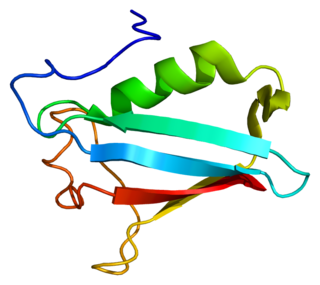
N-ethylmaleimide-sensitive factor, also known as NSF or N-ethylmaleimide sensitive fusion proteins, is an enzyme which in humans is encoded by the NSF gene.

Synaptosomal-Associated Protein, 25kDa (SNAP-25) is a Target Soluble NSF (N-ethylmaleimide-sensitive factor) Attachment Protein Receptor (t-SNARE) protein encoded by the SNAP25 gene found on chromosome 20p12.2 in humans. SNAP-25 is a component of the trans-SNARE complex, which accounts for membrane fusion specificity and directly executes fusion by forming a tight complex that brings the synaptic vesicle and plasma membranes together.

Syntaxin-1A is a protein that in humans is encoded by the STX1A gene.

Syntaxin-4 is a protein that in humans is encoded by the STX4 gene.

Vesicle-associated membrane protein 2 (VAMP2) is a protein that in humans is encoded by the VAMP2 gene.

Golgi-associated PDZ and coiled-coil motif-containing protein is a protein that in humans is encoded by the GOPC gene.

Synaptobrevin-like protein 1 (SYBL1), also known as vesicle-associated membrane protein 7 (VAMP7), is a protein that in humans is encoded by the VAMP7, or SYBL1, gene.

Syntaxin-6 is a protein that in humans is encoded by the STX6 gene.

N-ethylmaleimide-sensitive factor Attachment Protein Alpha, also known as SNAP-α, is a SNAP protein that is involved in the intra-cellular trafficking and fusing of vesicles to target membranes in cells.

Vesicle-associated membrane protein 3 is a protein that in humans is encoded by the VAMP3 gene.

NSFL1 cofactor p47 is a protein that in humans is encoded by the NSFL1C gene.

Vesicle-associated membrane protein 8 is a protein that in humans is encoded by the VAMP8 gene.

Syntaxin-binding protein 2 is a protein that in humans is encoded by the STXBP2 gene.

Guanine nucleotide-binding protein G(T) subunit gamma-T1 is a protein that in humans is encoded by the GNGT1 gene.

DnaJ homolog subfamily C member 5, also known as cysteine string protein or CSP is a protein, that in humans encoded by the DNAJC5 gene. It was first described in 1990.

BET1-like protein is a protein that in humans is encoded by the BET1L gene.

Calcium-dependent secretion activator 1 is a protein that in humans is encoded by the CADPS gene.

BET1 homolog is a protein that in humans is encoded by the BET1 gene.

Beta-soluble NSF attachment protein is a SNAP protein involved in vesicular trafficking and exocytosis which is encoded by the NAPB gene humans is.

Soluble N-ethylmaleimide-Sensitive Factor Attachment Proteins are a family of cytosolic adaptor proteins involved in vesicular fusion at membranes during intracellular transport and exocytosis. SNAPs interact with proteins of the SNARE complex and NSF to play a key role in recycling the components of the fusion complex. SNAPs are involved in the priming of the vesicle fusion complex during assembly, as well as in the disassembly following a vesicle fusion event. Following membrane fusion, the tethering SNARE proteins complex disassembles in response to steric changes originating from the ATPase NSF. The energy provided by NSF is transferred throughout the SNARE complex and SNAP, allowing the proteins to untangle, and recycled for future fusion events. Mammals have three SNAP genes: α-SNAP, β-SNAP, and γ-SNAP. α- and γ-SNAP are expressed throughout the body, while β-SNAP is specific to the brain. The yeast homolog of the human SNAP is Sec17, the structural diagram of which is included on this page.






















